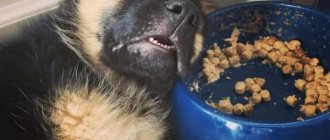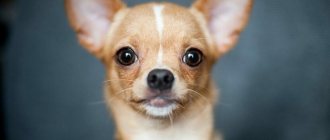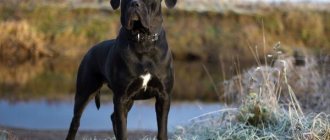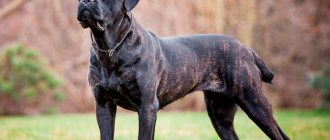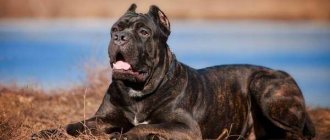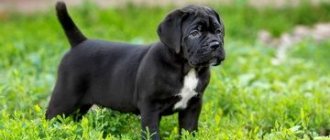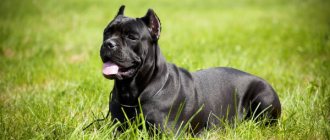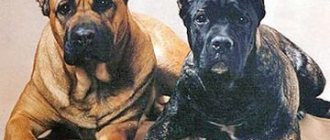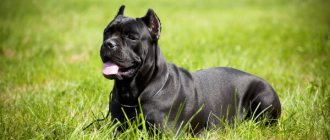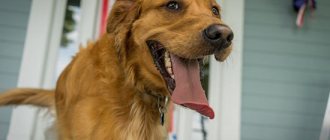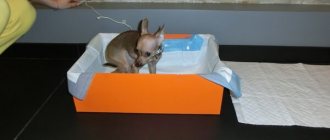Large and strong, the Cane Corso pet requires a special attitude to the preparation of the diet, since it The composition of the food depends on the physical condition and health of the dog.
A novice owner, thinking about what to feed a Cane Corso, a puppy or an adult dog, gets lost in the abundance of information. Many manufacturers offer various brands of ready-made food, breeders praise natural nutrition, veterinarians recommend dietary or medicinal food. So what to feed your Cane Corso with such an abundance of offers, how to choose the optimal diet for your pet?
Briefly about the breed
This breed is the pride of Italy, it is the 14th breed of dog that was bred in this country . The character of the Cane Corso reflects the courage of a fighter, the dedication of herding dogs, as well as the temperament of Italians.
The Cane Corso strives to protect its owner, protect the home and its own area. It differs from other guard dogs in that it rarely shows aggression towards uninvited guests, only when it feels a real threat to the owner or his property.
To this day, controversy continues regarding the origin of the name of the breed..
There are many versions, but most researchers are inclined to believe that the name of the breed comes from two words: “yard” and “dog”. Literally a yard guard dog.
The Cane Corso is a powerful, robust, extremely strong dog that is both menacing and elegant..
But for a dog to be healthy and active, it needs to be fed properly. This will be discussed below.
Two to seven weeks
During this period, the dog’s character is formed and he is ready for simple training. It is already clear who will have the makings of a leader. Depending on this, the method of training for a given period is selected. It is recommended to “push” inactive children to move, and to simply observe and make sure that active children do not harm themselves or spoil valuable things. Under no circumstances should you punish them, otherwise they will grow up fearful or aggressive.
It is important that puppies can have contact with people, then they will treat them normally, and strangers in the house will not cause aggression or fear in the dog.
If the dog refuses to eat: possible reasons
If your dog does not have a good appetite, this indicates:
- the appearance of internal parasites;
- recent vaccination;
- oral injuries;
- diseases of the gums and teeth;
- stress after a change of environment;
- apathy due to abuse.
If additional symptoms appear in the form of vomiting, dullness of the coat, elevated body temperature, lethargy, you should urgently contact a veterinarian for advice.
Natural or artificial food?
When asking the question of what is better - natural food or artificial food, a reasonable person is unlikely to take one position.
After all, it is clear that both natural and industrial food are quite suitable for keeping a dog, the only question is the quality of the food and the correct feeding of the dog.
It is believed that the Cane Corso is one of the most expensive dogs keep .
The fact is that this breed is quite prone to allergies, as a result of which the owner has to buy expensive hypoallergenic food for his pet for life.
As for the natural diet, it requires constant adjustment depending on the dog’s health and the season..
When feeding a dog, we must not forget that even the highest quality natural products cannot provide it with the required amount of minerals and vitamins.
Expert opinion
Kozhevin Semyon Kirillovich
Expert dog handler.
Most veterinarians recommend feeding your Cane Corso both natural and commercial foods. Of course, industrial food makes the owner’s life much easier, since it is balanced and all the calories in it are counted. It is important to remember the following rule - you cannot mix natural and industrial food, since this can significantly harm the dog’s digestion. If the pet is on artificial food, treats for it should also be selected from industrial ones, but if the dog is fed “natural”, natural favorite foods or pieces of dried meat should be used as treats. You should definitely choose commercial food in strict accordance with the age of the dog. Food for active young dogs contains more vitamins than food for older dogs, and an excess of vitamins and calcium can negatively affect the dog's health.
FEEDING THE PUPPY
When preparing for the arrival of your puppy, think in advance about what kind of dishes your puppy will eat from. The dishes from which the dog eats must be unbreakable. Aluminum or enameled bowls are suitable for this. The inner surface of the bowl must be perfectly smooth and not chipped, otherwise the dog will damage its tongue when it starts to lick it clean. The most convenient cookware is made of stainless steel. Plastic bowls are much less durable and very short-lived. It is better that from childhood, while eating, the dog reaches up to a bowl placed on a stand (you can make it yourself, but, in principle, now such stands on brackets are sold in many “dog stores, and buying them is not a problem), which is fixed on a tripod, depending on the height of the animal, at the level of the elbows or slightly higher. Thanks to this, your pet will develop correct posture. Be sure to ask the breeders what food the puppy is accustomed to at the time of sale. Weaning from its mother, the disappearance of siblings, an unfamiliar environment - all this creates serious stress for the puppy, so he may have a poor appetite during the first days in your home. Don't worry! To make the change in living conditions painless, try to maintain his usual diet. In the future, you can gradually accustom your dog to the feeding regimen that you consider most optimal.
In general, feeding schemes can be divided into three groups:
Traditional feeding
The dog is fed only natural products: stews based on meat, cereals and vegetables, cottage cheese, raw meat, fish. If the diet is chosen correctly, the dog will be in great shape, and the quality of its nutrition can only be envied. But this scheme at the same time has serious disadvantages: it is a rather labor-intensive option for the owner, requires a lot of time, and is not always the cheapest. If the diet is chosen incorrectly, then as a result of an imbalance, various diseases can occur: vitamin deficiency and hypervitaminosis, rickets, etc. Unfortunately, it often happens that owners who feed natural food skimp on meat in every possible way; the dog ends up with practically naked porridge, which, of course, is no good.
Feeding dry food
Now in Russia you can buy food from a variety of companies, but it is still better not to use little-known products; low-quality dry food, naturally, will not bring any benefit to the dog. Well-known manufacturing companies produce a wide range of foods designed for dogs of different age groups and leading different lifestyles. Provided that the food is properly selected, this option is good from all sides: it saves the owner’s time and effort, while at the same time the dog receives a complete, balanced diet, with the correct ratios of proteins, fats, carbohydrates and vitamins.
Balanced food ensures harmonious growth and development of the dog’s skeleton, teeth, muscles, and excellent coat condition. Many companies, in addition to dry food, produce canned food that can be added to food - dogs, as a rule, really like them.
Mixed feeding
Using high-quality dry food plus meat, cottage cheese, kefir. With such a feeding scheme, one rule must be strictly observed. You should not mix dry food with natural food in one bowl - you give the dog only dry food at one feeding, and for example, kefir or cottage cheese at another. Cottage cheese, best homemade (the ratio of milk and kefir is 1:1), meat (preferably pre-frozen lean beef), fish (only sea: cod, hake, ice fish; under no circumstances give your puppy fatty fish and pollock) , brown bread crackers. From cereals - buckwheat and rice. Hercules porridge often leads to intestinal upset, so it can only be given if the dog digests it normally.
What conclusion can be drawn from all of the above? There are adherents of different feeding schemes. You can choose any scheme. If your dog is in good shape - it is not losing weight or gaining weight, it has no signs of allergies, its coat is in good condition and shiny - then your feeding option is suitable for your pet. If not, then there are serious shortcomings in your feeding scheme, and it makes sense for you to review and correct it.
The following ratios should be observed in the diet of an adult dog: meat food - 10-20 g/kg weight, fat - 1-2 g/kg weight, carbohydrates - 5-6 g/kg weight. For puppies these figures are 2-3 times higher. The number of feedings depends primarily on age. A puppy of one to two months should be fed 5-6 times a day, a puppy of three or four months - 4 times, five months and older - 3 times. Adult dogs are usually fed twice a day: morning and evening.
If you decide to feed your puppy dry food, it is very important to choose the right one. So, the food of all reputable companies is divided into various groups according to energy value, content of vitamins and minerals and takes into account the needs of the dog from the moment of birth until the end of its life. There are foods for small puppies, teenage puppies, adult and aging dogs, nursing bitches, dogs with increased and decreased physical activity, long-haired dogs, etc. The required amount of food per dog's weight is indicated on the packaging. All this is quite individual, because dogs, like people, have different metabolisms. One dog may eat very little and be fat, while another may have to be given double the amount of food to be in normal shape.
Good condition of a dog is determined as follows: the dog's ribs should be palpable when lightly pressed. If the dog’s ribs are easily palpable, the groins are tucked in, the waist is clearly visible, the ridge is visible - this means that the dog is exhausted, which is completely unacceptable.
A very fat dog is also bad. Firstly, it’s simply not aesthetically pleasing; with such a dog you can’t count on good results at shows. Even a beautiful thoroughbred head in the presence of such a huge body seems disproportionately small. Your back may sag and your legs may move. But the saddest thing is that an obese dog cannot be healthy. She may develop many diseases, including coronary heart disease.
Some dogs have an allergic reaction to certain foods. If you are starting to give your dog new food, you should not immediately buy large bags. Feed a small bag first, if there is no allergy, the dog is in good shape, only then can you switch to this food. Good companies have special lines of food intended for dogs with allergies (lamb with rice).
Whatever feeding plan you follow, remember that:
Do not feed dogs hot, cold, spicy, salty, fatty, sweet or smoked food. The dog should not know what sausages, sausage, or ham are. We know many owners who are capable of doing the incredible for their pet and will not stand up to any expenses or difficulties. In this case, all this is completely in vain. Sausages are poison for dogs. They damage the liver, and the dog runs the risk of dying at a young age. After all, we don’t know what additives are added to sausages to make them look attractive.
The following should be excluded from your dog's diet:
• Broth, even the most dietary one;
• Pork – pork meat is too fatty, which puts a lot of stress on the liver;
• Lamb – also too fatty for dogs;
• Raw river fish – in most cases, river fish is affected by helminth larvae (worms). The fish must be boiled and all the numerous bones removed;
•Bones - contrary to the deep-rooted misconception, bones are death for a dog. Firstly, they are not digestible. Secondly, they can cause constipation, intestinal perforation, and volvulus. Particularly dangerous are tubular bones, which tend to split into sharp pieces. Bones also help teeth wear down quickly;
• Pasta - has no nutritional value, stretches the stomach and causes fullness.
• Any alcohol can lead to coma and even death;
• Salt - in large quantities, it disrupts the water and electrolyte balance of the body, which can lead to muscle cramps and spasms, or even congestive heart failure;
• Peas, beans and other legumes are not food for a dog, it is not a pig, dogs do not have good enough removal of gases from the intestines.
• Mushrooms - may contain toxins that cause damage to the liver and kidneys;
• Chocolate – contains theobromine, a heart stimulant and diuretic. This can be fatal for the dog;
•Sugar and sweets - sweets spoil the appetite and disrupt digestion. In addition, they destroy teeth and have an extremely adverse effect on the eyes, which begin to water;
•Yeast dough is the cause of gas and bloating, leading to rupture of the digestive system and hernia;
• Grapes and raisins – grapes contain an unknown substance that destroys the dog’s kidneys; citrus oil extracts - may cause vomiting;
• Broccoli - toxic in large quantities;
• Most fruit pits and seeds - contain cyanogenic glycoside, which leads to cyanide poisoning. Although the fruit itself is not harmful;
• Spices - pepper, bay leaf, spicy tomato sauce and nutmeg. Nutmeg can cause convulsions and seizures and damage the central nervous system;
• Onions and garlic - contain a toxic component - thiosulfate. Onions are more dangerous because... contains more of this toxin;
• Coffee and tea are dangerous due to caffeine;
• Human vitamins - especially those containing iron, cause damage to the liver and kidneys;
• Potato peels and green potatoes - contain oxalate, which can affect the digestive, nervous, and urinary systems;
• Poor-quality, spoiled dry food – dry food is a very good breeding ground for microorganisms, which successfully multiply in it if storage conditions are violated;
• Poor quality products – often leads not only to gastrointestinal disorders, but also causes food poisoning;
• Moldy, rotten, sour, spoiled food - no comments necessary.
Never forget that there should always be clean and fresh water in a separate bowl!!!!
Dry food rating
GASTAT
I came across an interesting article, maybe it will be useful to someone
Rating of dry dog food
The world produces a huge amount of dry food for dogs and cats under an incredible number of brands. Many of them are practically unknown in Russia. But if you start monitoring foreign sites, a rather interesting picture emerges. The foods that are most popular in Russia and considered by our compatriots to be of the highest quality have the lowest ratings in dog food ratings. It is their products that most often appear on the lists of foods recalled from sale due to danger to the lives of pets and even due to deaths after consuming these foods (proven in laboratory). Understanding that collecting and analyzing information on food in the vast sea of the Internet is extremely difficult and uninteresting for many, I will briefly post a rating of dry dog food from those presented on the Russian market. The highest score is 6 and then descending. According to tests conducted from October to December 2008, the highest quality feeds include: - The best feeds. Expensive, but very useful. Excellent quality, most serious technologies and developments. Due to the highest balance, the daily intake is low, that is, almost everything is digested. It is even noticeable that less feces are excreted - everything is processed into energy. These are foods that restore pets after various diseases, including those caused by low-quality competitors. Innova EVO Innova EVO Red Meat Innova EVO Reduced Fat Orijen 6 Fresh Fish Orijen Adult Orijen Puppy Orijen Puppy Large Orijen Senior
— High-quality, very good food. Some who were previously included in the highest class, but, due to non-compliance with the highest standards, were transferred to a lower class. If you are already using them and are satisfied with the result, then you should not change to first category food. Acana Grasslands Acana Pacifica Acana Prairie Harvest Canidae All Life Stages Canidae Beef & Fish Canidae Grain-free ALS formula Canidae Grain-free Salmon Meal formula Chicken Soup For The Puppy Lover's Soul Innova Adult Dry Dog Food Innova Adult Dry Dog Food – Red Meat Innova Puppy Dry Puppy Food - Good food that contains virtually no harmful ingredients. But in terms of the ratio of animal and plant components they cannot be included in the highest categories. Acana Puppy Large breed Acana Adult Dog Acana Adult Large Breed Acana Lamb & Apple Acana Light & Fit Acana Puppy & Junior Acana Puppy Small Breed Acana Senior Dog Acana Small Breed Acana Sport & Agility Canidae Chicken & Rice Canidae Lamb & Rice Chicken Soup For The Dog Lover's Soul Chicken Soup For The Puppy Lover's Soul Large Breed Eagle Pack Holistic Select Anchovy, Sardine & Salmon Meal Formula Eagle Pack Holistic Select Chicken Meal & Rice Formula Eagle Pack Holistic Select Duck Meal & Oatmeal Formula Eagle Pack Holistic Select Lamb Meal & Rice Formula Eagle Pack Holistic Select Large & Giant Breed Adult Formula Eagle Pack Holistic Select Large & Giant Breed Puppy Formula Innova Large Breed Adult Dry Dog Food Innova Large Breed Puppy Dry Innova Large Breed Senior Dry Dog Food Innova Senior Plus Dry Dog Food Nutro Ultra Holistic Adult Nutro Ultra Holistic Puppy Nutro Ultra Holistic Small Breed Adult Techni-Cal Natural Blend Puppy Techni-Cal Natural Blend Salmon & Potato - There is no point in considering in detail due to the low quality of the food presented and their huge quantity. Many of them are not only equal in cost to the feeds of the higher groups, but superior to them. Economical food is of low quality - little digestible protein, few vitamins, not very balanced, ingredients are not carefully selected. Most outbred animals are able to sit on this food without any special health problems. I really don’t recommend feeding kittens (puppies) with them, even with special formulas for kittens (puppies) from the same company. Once your pet reaches at least two years of age, if your financial situation does not allow anything more serious, you can afford such a diet. There are more than a hundred foods on the list, so here I will only list those that are most often found in pet stores. Bozita Robur Breeder 30/15 Bozita Robur Maintenance 27/15 Bozita Robur Performance 33/20 Canidae Platinum (Senior/Overweight) Chicken Soup For The Dog Lover's Soul (Light) Chicken Soup For The Dog Lover's Soul Large Breed Chicken Soup For The Dog Lover's Soul Senior Diamond Beef Meal & Rice Formula for Dogs Diamond Large Breed Adult Diamond Naturals Beef Meal & Rice Adult Formula Diamond Naturals Chicken & Rice Adult Formula Diamond Naturals Extreme Athlete Diamond Naturals Lamb Meal & Rice Adult Diamond Naturals Large Breed 60+ Adult Formula Diamond Naturals Large Breed Puppy Lamb & Rice Diamond Naturals Small Breed Adult Chicken & Rice Formula Diamond Naturals Small Breed Adult Lamb & Rice Diamond Naturals Small Breed Puppy Formula Eagle Pack Holistic Select Senior Care Formula Eagle Pack Puppy Chicken & Oat Bran Formula Eagle Pack Senior Care for Dogs Forza10 Puppy Junior Forza10 Puppy Junior Diet Happydog Supreme Ireland Happydog Supreme Toscana Innova Low Fat Adult Dry Dog Food Innova Senior Dry Dog Food Karma Organic Nutra Gold Adult Nutra Gold Indoor Dog Microbites Nutra Gold Lamb & Rice Adult Nutra Gold Large Breed Adult Nutra Gold Large Breed Puppy Nutra Gold Puppy Nutra Gold Puppy Microbites Nutra Gold Salmon & Potato Nutra Gold Weight Control PRO PAC Earthborn Holistic Premium Dog Food Professional (full line) Regal Active Bites Regal Adult Bites Regal Lamb Bites Regal Puppy Bites Regal Sensi Bites Regal Venison Bites Royal Canin Medium Breed Adult 25 Royal Canin Mini Puppy 33 Royal Canin Mini Toy Indoor Adult 25 Royal Canin Veterinary Diet (almost the entire line) Techni-Cal Canine Lamb & Rice Techni-Cal Canine Sensitivity+ Easy To Digest Techni-Cal Natural Blend Adult Techni-Cal Natural Blend Duck & Oatmeal Techni-Cal Natural Blend Senior - The most disgusting in terms of quality and abundance of negative reviews and tests. There is practically no meat, there is nothing to put it here. The predominant products are millet, bran, and meat production waste. Sources of animal tissue are offal, which is generally good, but not in such quantities. There is generally silence regarding vitamins. It is only permissible for low-income owners, or fanatical owners of a zoo in the house, which, even with such a diet, eats up the bulk of the income. The animal will live. It’s amazing, but many people even live for a very long time and without any special health problems, and they get used to this. It’s not for nothing that they say: “Heals like a dog,” or “A cat has nine lives.” They adapt to look for scraps, save vitamins in the liver to the last crumb, and even reproduce well. The list is huge, so I’m giving it very selectively, a couple from each well-known manufacturer: 1st Choice (almost the entire line) Belcando (almost the entire line) Bozita Robur Light & Sensitive 07/19 Diamond Naturals Senior 8+ Formula Eagle Pack Adult Small Bite for Dogs Eagle Pack Kennel Original Adult Eagle Pack Large & Giant Breed Puppy Formula Eagle Pack Maintenance Formula Chicken Meal and Rice for Dogs Eagle Pack Natural Lamb & Rice for Dogs Eagle Pack Power Pack for Dogs Eukanuba (almost the entire line) Forza10 (almost the entire line) Happydog Light Croq Happydog Mini Croq Happydog Premium Croq Happydog Supreme Neuseeland Hills Prescription D/D Potato & Salmon Hills Prescription D/D Potato & Venison Hills Prescription D/D Rice & Egg Hills Prescription J/D Iams ProActive Health Adult Lamb Meal & Rice Formula Iams Veterinary Formulas Skin & Coat Response FP/Canine Dry Formula Royal Canin Medi-cal (full line) Hills Nature's Best Canine Adult Large/Giant Hills Nature's Best Canine Adult Mini/Medium Nutra Gold Senior Nutra Nuggets Lamb Meal & Rice Nutro (full line) Nutro Natural Choice (whole line) PRO PAC Puppy Lamb Meal & Rice Formula Premium Puppy Food Pro Plan Selects (whole line) Pro Plan Sensitive Skin and Stomach Formula Pronature (whole line) Purina Naturally Complete Dog Chow Purina Veterinary Diets DH Dental Health Canine Formula Regal Lean Bites Royal Canin (the rest of the line) Royal Canin Veterinary Diet (everything not included) Supreme Ireland Salmon & Rabbit Supreme Neuseeland Lamm Supreme Toscana Techni-Cal Canine Adult Techni-Cal Canine Bone & Joint Techni-Cal Puppy - An excellent choice for flayers, much better than strychnine - it’s too fast, you don’t have time to get full pleasure from contemplating the slow death of your charges. An interesting fact is that food in this category is not the cheapest, the penultimate category is cheaper on average, apparently a sadistic service is included in the price of the product, in addition to the cost of hooves, feathers, intestines, peelings and drugs. Advance (entire line) Belcando Multi-Croc Bozita (entire line not included in ) Chicopee (entire line) Diamond Hi-Energy Sporting Dog Formula Diamond Low-Fat Formula Diamond Maintenance Diamond Originals Diamond Performance Formula for Dogs Diamond Premium Adult Diamond Puppy Formula Eagle Pack Adult Reduced Fat Formula for Overweight or Less Active Dogs Eukanuba Adult Large Breed Formula Eukanuba by Breed Eukanuba Large Breed Premium Performance Eukanuba Puppy Large Breed Formula Eukanuba Puppy Medium Breed Formula Eukanuba Puppy Small Breed Formula Eukanuba Senior Large Breed Maintenance Formula Eukanuba Sensitive Stomach Happydog Sano Croq Hill's Science Diet (most of the line) Hills Prescription (whole line) Iams (rest of the line) Nutra Nuggets (whole line) Pedigree (whole line) PRO PAC (whole line) Pro Plan (almost the whole line) Purina (almost all line) Purina Veterinary Diets (entire line) Royal Canin (several types) Techni-Cal Canine Senior Techni-Cal Canine Weight Control As you can see, 99% of our most common and promoted foods are in the lower categories.
General recommendations
Before planning your Cane Corso's diet, you need to understand that various types of allergic reactions are very common among this breed..
You can determine the allergen in a particular case using the exclusion method and remove this product from the diet; When feeding dry food, it is better to use hypoallergenic food.
Another important issue is the dog’s weight.
Even at a young age, excess fat can have a very negative impact on the condition of the dog’s joints, therefore it is recommended to adhere to the following rules that will help control the dog’s weight at any age:
- You need to feed the Cane Corso strictly following the daily norm; if desired, this norm can be divided into several (2-3) meals, but you cannot feed the dog in excess of the prescribed norm.
- It is imperative to compare the amount of carbohydrate food with the dog’s physical activity. If the load is low, the calorie content of the diet should also be reduced.
- If a dog eats artificial food, it may often ask for more. This is due to the fact that dry food increases in volume only after it enters the stomach. Therefore, immediately after eating, the dog may not feel full. If the owner cannot steadfastly withstand the gaze of pleading eyes, he can give the dog a bone from the tendons, but not an additional portion of food.
- The dog must be weighed regularly.
Feeding recommendations for large breed dogs
Large dogs have no less appetite. Individuals with large dimensions have a slower metabolism, they need fewer calories and fat, and they require a higher protein content to maintain shape.
Dry food for large pets varies in granule sizes. For large animals, they are produced about one and a half centimeters in diameter. A smaller granule size will not provide the jaws with full function, which is important for the dog’s health.
Adult pets are fed twice a day, after morning and evening walks. Breakfast and dinner take no more than a quarter of an hour. The bowl is removed even if the food is not eaten. The animal should always have access to clean, fresh water.
The daily amount of food for animals is not the same for equal sizes. It depends on the load experienced by the pet since the last meal. If your pet actively trains or spends a lot of time walking outside, the serving size is increased by a third. If the load is reduced, the pet does not walk much, rests or sleeps more time, the portion is reduced by about 15 percent.
The main indicator of a proper diet is a healthy, well-fed, strong dog whose weight is within the normal range for its age.
Large active animals, service animals, workers, need high-quality nutrition. Suitable feeds marked “energy” or “active”, varieties of “super-premium” or “premium” classes. They contain enough calories, are nutritious, and help improve the digestive system. This diet includes vitamins, dietary supplements, proteins, and amino acids.
It is impossible to give the animal food before training, an active walk or immediately after. Large dogs are at much higher risk of developing volvulus or intestinal blockage than their smaller dogs. These situations are dangerous and require urgent veterinary intervention. After a significant load, you can give the animal to eat after about one hour.
Origin story
The ancestors of the breed are Molossian dogs. In ancient times, Cane Corsos served as guards, took part in battles and military operations, and tended herds. As time passed, firearms began to be used in battles, and the need for military dogs disappeared. Already at the beginning of World War II, the number of animals decreased significantly.
Today Italians call the Cane Corso their pride. However, despite its cultural and historical significance, the breed was on the verge of extinction even in Italy. It was preserved by a group of enthusiasts who went in the 70s of the last century to look for preserved individuals to where the breed originated - to Locatia, Puria, Sicily.
They managed to preserve the ancient beauty. The breed was officially recognized by the Italian Canine Association in 1994, and in 1996 by the international organization FCI. In 1999, the Association of Italian Cane Corsos was founded. The standard was adjusted and came into force in 2003. It is still used today by the International Cane Corso Federation.
Pros and cons of natural nutrition
The benefits of natural nutrition:
- the owner knows exactly what he feeds the dog and chooses the quality of the food himself;
- lack of preservatives and artificial colors;
- if you have allergies, you can replace products;
- The dog's diet contains protein, carbohydrates, fats and fiber.
Minuses:
- it is necessary to spend time preparing food;
- you need to choose the right diet so that the animal receives all the necessary vitamins and microelements;
- it is necessary to introduce vitamin supplements into the diet;
- It is difficult to take a natural dog on a trip, since you will have to look for a hotel where you could prepare food for it.
However, if the owner decides to feed the dog natural food, he should know what products can be used for this:
- boiled or raw meat;
- fish;
- boiled vegetables;
- porridge;
- eggs;
- dairy and fermented milk products.
It is recommended to give the Cane Corso fish oil, salmon oil, and vitamin and mineral complexes as supplements.
Prevention
In order to prevent the occurrence of diarrhea in puppies, first of all, the owners who have taken responsibility for the life and health of their four-legged friend must create optimal living conditions for the pet and systematic care.
It is very important to think about the type of food (natural, ready-made food), follow the feeding regime and norms. The diet should be nutritious, balanced, and of high quality. If the dog is kept on natural feeding, supplement its menu with vitamin and mineral complexes and supplements. If you prefer ready-made industrial feed, choose products from well-known brands and brands marked premium, “extra” class.
To avoid causing stomach upset or metabolic disorders, do not give your puppy food from your table. Smoked foods, spicy, pickled, salty foods, and fatty foods are prohibited . Do not give your dog tubular bones, raw fish, as well as meat products, offal of questionable quality or that have not undergone heat treatment. Food should be fresh, at room temperature. Don’t forget, your dog should always have fresh drinking water in his bowl, keep the dishes clean, and regularly clean the feeding area.
Do not forget about the need for preventive immunizations and deworming. Treat your puppy's fur against ectoparasites, which are carriers of dangerous viruses and bacteria. The optimal vaccination schedule and drugs to combat endo-ectoparasites will be selected by your veterinarian.
We recommend taking your pet to a veterinary center twice a year for a comprehensive diagnosis. Remember the life and health of the puppy is in your hands!
What not to feed your Cane Corso
The following foods may be harmful to your health:
- boiled bones, tubular (bones can get stuck in the throat);
- pork;
- salo;
- chicken and goose skin;
- marinades, pickles, spices, smoked meats;
- confectionery, baked goods;
- River fish.
In addition, owners should be aware of products that can cause allergies: eggs, chicken, mackerel, water containing impurities, complex vitamins, some types of feed.
Advantages and disadvantages of artificial feed
pros:
- no need to cook;
- no need to calculate portion sizes;
- no additional vitamin supplements are needed;
- variety of feed;
- the ability to take food on the road.
Minuses:
- there is no clear idea about the nature of the production of the food, and it is not a fact that it actually contains natural ingredients, as indicated on the packaging;
- improperly selected food can cause an allergic reaction;
- Cheap feeds use soybeans and low-quality by-products instead of meat;
- feed is produced at high temperatures, which leads to the destruction of vitamins;
- The food may contain preservatives and emulsifiers, which can lead to serious illnesses for the dog.
On the market, all industrial feeds are divided into:
- Economy - both legumes and grains are produced, bone meal, chicken waste, and vegetable oil are added. Often these foods contain dyes and flavoring additives. No vitamins. It is not recommended to feed Cane Corso this food.
- Premium - not much different from the previous class, but it does not contain dyes.
- Super premium - contains natural products (meat, fish, poultry), legumes, supplements for the skeletal system, plant extracts. Example – Royalcanin, Bosch.
- Holistic – only high-quality products, vitamins, probiotics. Example – Akana, Innova.
Ready-made food for large pets
Before the owner starts giving the dog dry food, you should carefully study the composition. It matters how much protein is present in the food and whether there are no artificial flavors or aromas.
How much and how often to feed
It is worth using high-quality super-premium food. It is based on meat products and grain crops. With high activity of an adult carne corso, the portion of food should be 530-550 g per day, with low activity 380-440 g.
Is it possible to combine ready-made food with natural food and how to do it correctly?
When combining natural and dry dog food, it is worth studying the composition and calculating the amount of each necessary component. This is necessary so that the dog receives a full range of nutrients. If the owner is inattentive, the Cane Corso can get an excess of one component and a shortage of another. This leads to diseases of the stomach and intestinal tract in dogs.
Mixed feeding is more often used when switching from natural products to dry food or vice versa. This can lead to an unbalanced diet. On the other hand, a mixed diet prevents the development of urolithiasis, diabetes, obesity and cystitis.
Note! The cost of complete nutrition with natural products corresponds to the purchased quality food.
How to change the power plan
When changing your pet's diet, you need to approach it individually. The safest option is considered to be transfer for 10-14 days. This will help protect your pet from indigestion. Each new product is introduced gradually, no more than once every 2-3 days. You should definitely monitor the dog’s general condition and digestive waste.
Clinical picture of diarrhea
Diarrhea (diarrhea) is a condition characterized by frequent bowel movements. The excrement has a mushy, thin, watery consistency. Diarrhea in dogs can be acute or chronic, which occurs periodically if the negative factors that caused the diarrhea continue. But as a rule, constant diarrhea indicates profound changes and disturbances in the body.
Important! Chronic diarrhea is most often observed in German shepherds, Great Danes, and Bordeaux dogs. Yorkies, South Russian Shepherds, Pinschers.
As already noted, indigestion is not an independent separate disease, but a symptom of some pathology, illness, or malfunction in the body. Therefore, in addition to diarrhea, owners should be wary of the following symptoms:
- pallor, yellowness, cyanosis (cyanosis) of mucous membranes;
- lethargy, apathy, depression, drowsiness;
- lack of response to external stimuli;
- refusal of food and favorite treats;
- dirty fur near the anus;
- increase in tummy volume;
- mucous, mucopurulent discharge from the nose, eyes;
- sudden increase/decrease in temperature;
- chills, fever;
- cough, difficulty shallow rapid breathing;
- change in heart rate;
- painful defecation, urination;
- refusal of water or vice versa, increased thirst.
The clinical picture, severity, and intensity of symptoms, if they are caused by an infection or disease, depend on the stage, form of the disease, individual characteristics, resistance, and immune potential.
If you notice that the puppy is not eating anything, has become lethargic, apathetic, and other side symptoms are noticeable, do not delay your visit to the veterinarian.
The faster qualified assistance is provided, the greater the chances of saving your beloved pet. Most infectious and bacterial diseases have an aggressive course and occur in an acute, subacute form. Some diseases can be cured at the initial stage of their development. At the same time, uncontrolled use of drugs or self-medication will not produce results and can cause serious consequences.
Types of diarrhea
The disease can occur in forms that differ in severity and strength of impact on the functioning of the body. In each case, this phenomenon is quite dangerous. Sometimes you can cope with it on your own, but if the type of disorder is really severe, you need to consult a specialist.
Diarrhea
Normally, a dog stools up to 4 times a day and has a dense shape. If it becomes more frequent and becomes liquid, the animal has diarrhea. Normal diarrhea consists of thin, even watery feces that are yellowish or greenish in color. A dangerous sign is the presence of a large amount of mucus in the discharge, a whitish color, indicating disturbances in the functioning of the intestines.
A single loose stool should not be considered a cause for concern - it also happens in healthy animals. But repeated repetition of the situation, combined with the lethargy of your pet, is a serious reason for alarm and contacting a doctor.
How to choose?
You need to choose only high-quality dry food that is suitable for the age and health of the dog.
An adult and active Cane Corso requires about 800 pellets per day.
IMPORTANT!
You can calculate the amount of feed as follows: per kilogram of animal body weight, about 30 grams of feed are required.
Veterinarians advise paying attention to super premium and holistic food.
Acana Puppy Large Breed, 11.4 kg
Acana Puppy appeals to every furry friend and turns into a favorite bowl. Transforms the animal's fur into smooth and silky, bones will be stronger, and more energy will appear. Thanks to these crackers, your beloved friend is provided with a balanced diet. Many breeders of our smaller four-legged brothers recommend them to everyone else. This is a holistic class.
- Natural.
- Without smell.
- Large packaging.
- High price.
- There is a fishy smell.
Treatment of infectious diarrhea
For bacterial, infectious diarrhea, veterinarians prescribe Levomycetin, Enterofuril (1 ml for every 2.5 kg), Nifuroxazide, Furazolidone. The dosage, frequency of administration, and duration of treatment are selected by the veterinarian in each specific case.
In addition to treating diarrhea, therapy is aimed at relieving general symptoms and normalizing the condition of the sick animal. Four-fingered patients are prescribed anti-inflammatory, restorative, antibacterial agents, and broad-spectrum antibiotics. To eliminate vomiting - Cerucal, Reglan, other antiemetic drugs. If a dog suffers from debilitating vomiting, the animal is completely limited in food and water. All necessary medications and medications for dehydration are administered intravenously (droppers).
Important! During treatment, owners must strictly follow all recommendations of the treating veterinarian.
The duration of treatment can take from four to seven or more days. Do not skip taking medications, do not exceed the dosage indicated in the instructions for the medication. Medicines in tablets are best crushed into powder, mixed with water and poured into the pet’s mouth using an introducer syringe or a regular one without a needle. You can also add them to food or give them with your favorite treat.
If the puppy is diarrhea due to helminthic infestation, in addition to the main treatment, complex anthelmintics (IN-AP, prazicide, drontal, milbemax) will be prescribed. For puppies, it is best to purchase an anthelmintic in suspension or in the form of sugar cubes. Such medicines have a pleasant taste, so the treatment will proceed without problems.
What to give a puppy for diarrhea
To stop diarrhea, use:
- adsorbents – remove harmful substances from the body (activated carbon, Smecta, Polysorb);
- antibiotics – stop an infectious or bacterial disease (Levomycetin, Furazolidone);
- antidiarrheals - used only for severe profuse diarrhea (Imodium, Loperamide);
- drugs for normalizing intestinal microflora (Mezik, Linex, Lactobacterin);
- hemostatic agents (Ditsinon and analogues).
If the cause of diarrhea is poor nutrition, then give the puppy adsorbents for diarrhea - this should be enough. At home, do not give any medications other than adsorbents if you are not sure of the causes of loose stools. Strictly follow your doctor's recommendations and medication instructions.
Reference! To treat diarrhea in dogs, the same medications are taken as for treating people. Therefore, the necessary medications can be found even in a home medicine cabinet; there is no need to look for a special veterinary pharmacy.
What should you add to your diet?
For dogs prone to allergic reactions, fish oil and various vitamin and mineral complexes are recommended.
You should give your dog salmon oil daily, as it contains the Omega acids he needs..
If the owner regularly feeds the dog, during the shedding period the dog will not actively lose hair; moreover, its coat will become shiny and healthy.
Features of feeding during pregnancy and after childbirth
During pregnancy and lactation, the dog uses more energy. After the 40th day of pregnancy, each serving of food and liquid should be increased by 25-50%. During this period, it is recommended to provide the dog with constant access to food, as long as it is not prone to obesity. Giving birth and feeding puppies contributes to the expenditure of calories. Fasting at this moment is much more dangerous.
During pregnancy and after childbirth, the female must eat intensively
Feeding a puppy and how much does an adult dog eat?
Up to 4 months, a Cane Corso puppy needs to be fed 4 times a day, up to 7 months – 3 times a day. After 7 months, the dog should be switched to two meals a day.
From 3 weeks of age, cheek feeding should be done every 3 hours . The menu should contain proteins, fats, carbohydrates, vitamins and minerals.
Up to 10 weeks, meat for a puppy needs to be ground, but it is not recommended to feed it with minced meat, since it is poorly digested by the dog’s body.
It is recommended to give your baby rye bread soaked in low-fat broth . From two months old, the dog needs to cook soups with milk, meat or fish broth, as well as liquid porridge from ground cereals.
The norm of liquid food should be 200 grams.
From 6 months you can introduce offal into the diet . Raw beef bones promote healthy and healthy teeth. It is recommended to give your dog a boiled egg, yogurt, cottage cheese, cheese, and butter.
The menu must include cereals and vegetables - carrots, zucchini, beets, cabbage.
The norm of food consumption is set individually . After the baby eats, you need to pay attention to his stomach. If it is swollen, it means the dog has eaten too much.
Next time you need to reduce the portion. If the puppy has eaten food, licked the bowl and, looking into the owner’s eyes, asks for more food, then the portion was not enough, this must be taken into account at the next feeding.
Water must be clean and odorless.
Natural products
Many owners feed their pets natural products. To do this, you need to know about the beneficial and prohibited types.
Permitted and prohibited products
You can diversify your dog's diet with the following products:
- chicken and rabbit meat, beef;
- offal;
- boiled sea fish;
- cow and goat milk;
- cottage cheese, kefir, yogurt;
- a small amount of vegetable oil or butter;
- wheat, corn, rice, oatmeal, pearl barley and buckwheat porridge;
- carrots, potatoes, beets, cabbage;
- fruits and berries;
- seaweed.
Prohibited products include:
- pork;
- salo;
- tubular raw and cooked bones;
- chicken and goose skin;
- smoked products, marinade, spices, pickles;
- river fish;
- pastries and sweets.
Attention! An allergic reaction can be caused by eggs, chicken, mackerel, water containing impurities, some complex vitamins and feed. Natural nutrition is the key to a healthy looking and active dog
Natural nutrition is the key to a healthy looking and active dog
Weekly menu for Cane Corso (natural food)
For a puppy over 2 months of age, you need to prepare food so that he receives the following amount of food per day:
- 100-200 g of meat;
- 450 ml milk;
- 1 yolk;
- 130 g cottage cheese;
- 150 g vegetables;
- 100 g cereals;
- 10 ml vegetable oil;
- 10 g of mineral fertilizer.
Attention! Vitamins should be given to your pet as prescribed by a veterinarian. This proportion should be gradually increased every month.
At the age of one year, the dog should receive the following amount of food every day:
This proportion should be gradually increased every month. At the age of one year, the dog should receive the following amount of food every day:
- 0.5 kg of meat;
- 2 eggs (2 times a week);
- 250 g cottage cheese;
- 250 g vegetables;
- 250 g of porridge from various cereals;
- 30 ml vegetable oil;
- 20 g of mineral fertilizer.
The owner must regularly monitor the pet's weight. If you are overweight, you should reduce your food intake by 50-100 g.
What to include in your daily diet
The daily diet of a puppy and an adult dog should contain foods containing proteins, fats, carbohydrates, minerals, and vitamins. From birth, you should start feeding your Cane Corso 6 times a day, gradually reducing the number of meals. An adult dog should be fed twice a day, although eating once a day is also allowed.
4-6 months
At 4 months, the dog has already reached a large size (height at the withers is 47 or 56 cm, depending on gender) and outwardly looks like an adult, but in behavior it is still a puppy who frolics and plays a lot.
Now the baby is not only trying to growl, but is also trying to establish a hierarchy in the family. It is very important to earn the dog’s respect and show that all family members, including children, must be obeyed. Otherwise, the dog will become uncontrollable and will feel like the mistress of the house.
Despite its large size, it is still a “child” who is often afraid even of familiar things. The owner must support the pet and show that the object or sound that frightened it is not dangerous.
Purina Pro Plan Optiderma for Healthy Skin and Coat, Salmon with Rice, 14 kg (Large Breeds)
A healthy body and the well-being of an animal are the result of its optimal nutrition. Purina Pro Plan was developed by Russian veterinarians and nutritionists. The composition includes specially selected nutritional components for four-legged pets of different sizes, weights and ages. It suits even special preferences and keeps the animal in excellent condition. Belongs to the premium class.
- Decent composition.
- Wide range for any age, size.
- Nutritious with all the vitamin complex.
- Flavoring additive.
- Doesn't cause much appetite.
- Not available everywhere.
- Creates increased gas formation.
Nutrition for an adult dog
The diet of an adult dog should include meat. In addition, offal and fermented milk products are needed.
The ideal fish for Cane Corso is blue whiting; it is given once a week, a kilogram per meal..
The menu should also include porridge in meat or vegetable broth with the addition of butter or vegetable oil. Vegetables are needed - pumpkin, carrots, zucchini, cabbage, fresh herbs.
As for treats, pieces of pear, peaches, apples are recommended.
NOTE!
When feeding a dog with industrial food, it is necessary to use high-quality food that is suitable for feeding adult dogs.
It is important to provide your dog with plenty of clean water.
Per kilogram of weight of an adult dog requires 30 grams of dry food and 50 grams of liquid food.
CHAPPI MEAT ABUNDANCE WITH VEGETABLES AND HERBS, adults
CHAPPI is produced in Russia for economy class. It contains cereals, which are considered the best sources of carbohydrates. Proteins are present in the form of meat and offal. Use vegetables, for example, carrots, vegetable oils. CHAPPI is convenient because there is no need to add vitamins to it; they are already contained in sufficient quantities.
- Wide availability.
- Nutritious food.
- Does not cause constipation in the animal.
- Decent quality.
- Promotes healthy appearance of coat and teeth.
- Doggies like it.
- There are no artificial flavors or flavor enhancers.
- Treatment of the animal after eating these dry granules.
- Bad composition.
- Allergic reactions.
- Hair falls out.
- Bloating.
- Not suitable for all individuals.
- Unattractive packaging.
First 4 years
The weight of an adult dog already reaches 45 kg for females and 55 kg for males.
As a rule, the first mating is carried out during this period. After it, the males again try to take leadership positions, but this time not within the family circle, but among other dogs. Thanks to their strength, Cane Corsos can cause great harm to other pets with whom they previously played during a walk. Under no circumstances should a dog be allowed to assert itself in this way.
The dog’s character can be adjusted up to three years of age, but the older he gets, the more difficult it is to do this.
